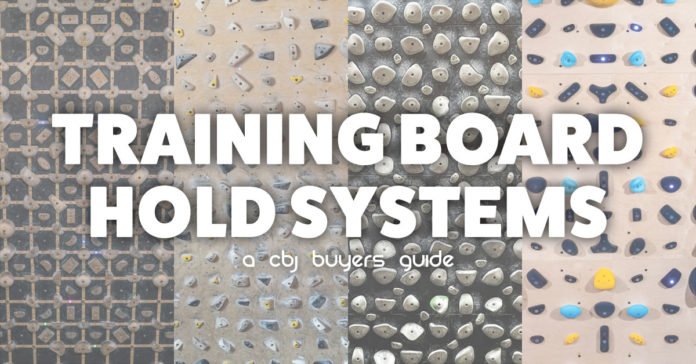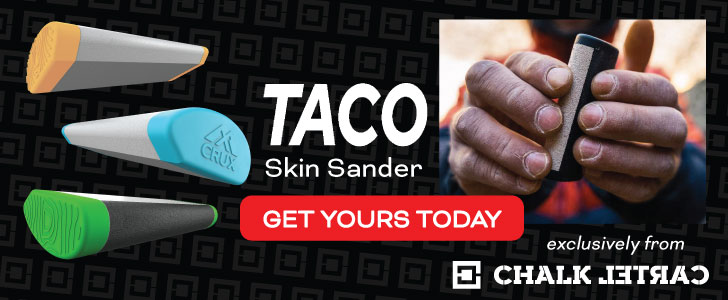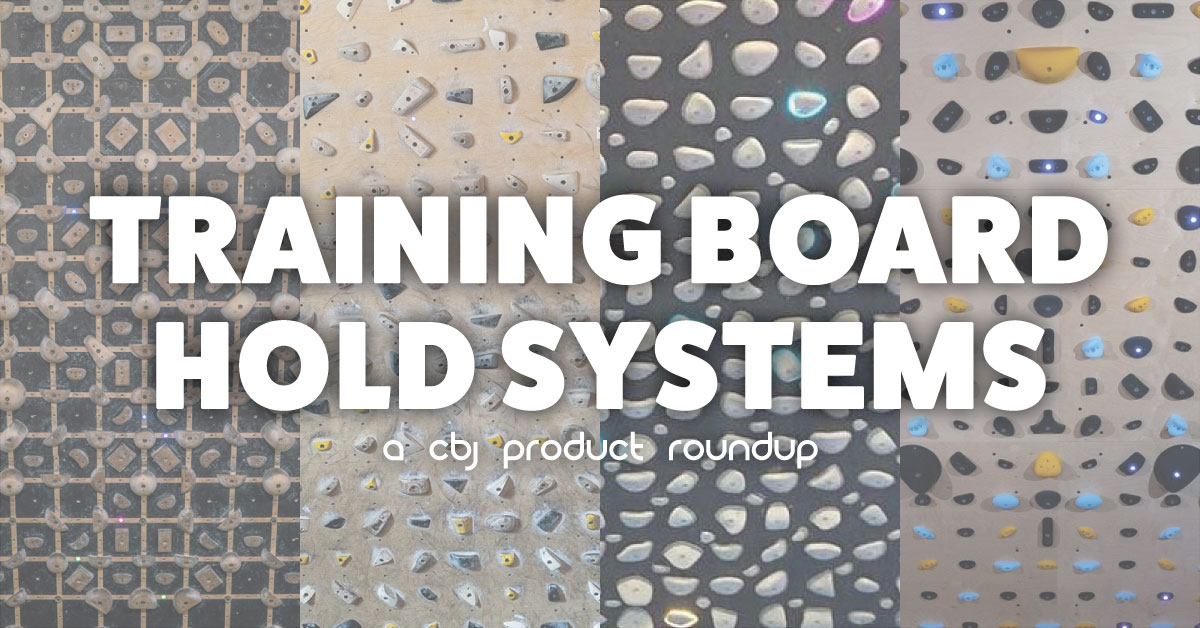
[Editor’s Note: This article was first published on November 18, 2021, and was updated on April 12, 2024, to reflect changes in the training boards market.]
The modern, standardized training board is an invaluable investment for climbing gyms large and small. By committing only a small fraction of a facility’s footprint for training boards, gym operators open up bottomless climbing options for a huge variety of customers. No routesetting is necessary since all systems come with an app packed with thousands of problems, and the only real maintenance required is cleaning the holds. No longer do private trainers or youth team coaches need to wander the gym to find climbs for their clients’ workouts.
“They create a friendly, or cutthroat, way for people to train together, whether in the same gym at the same time or with partners across the continents,” said Fabrizio Zangrilli, who at one point made use of five different board systems as a gym owner.
The concept of a training board is not new. Practically since the advent of indoor climbing, training aficionados have built “system boards”—often DIY mirrored walls that enable climbers to work on specific goals in a confined space, which are effective complements to a campus board and hangboard. But modern training boards take it to a whole new level, driven largely by technology. Combining LED lights and databases of routes on an app in your pocket―and built on a standardized layout that can be replicated anywhere in the world―the training boards of today can pack a lifetime of climbing into a 10×10-foot space.
With more hold systems being added to the market each year, in this update we further separated the training boards into their various versions in the table below—for example, Tension 1 and Tension 2—and added new players to the roundup.
There are several training board hold systems on the market today in North America. A few others are currently in use in other parts of the world, and it seems many new options are in development publicly and in secret.
In addition to training board hold systems, we cover training board frames in a separate article here, which will soon be receiving an update, as well.
All details above are accurate as of the publishing date. New options may have been added and prices may have changed since then, and new routes are added every day to the apps.
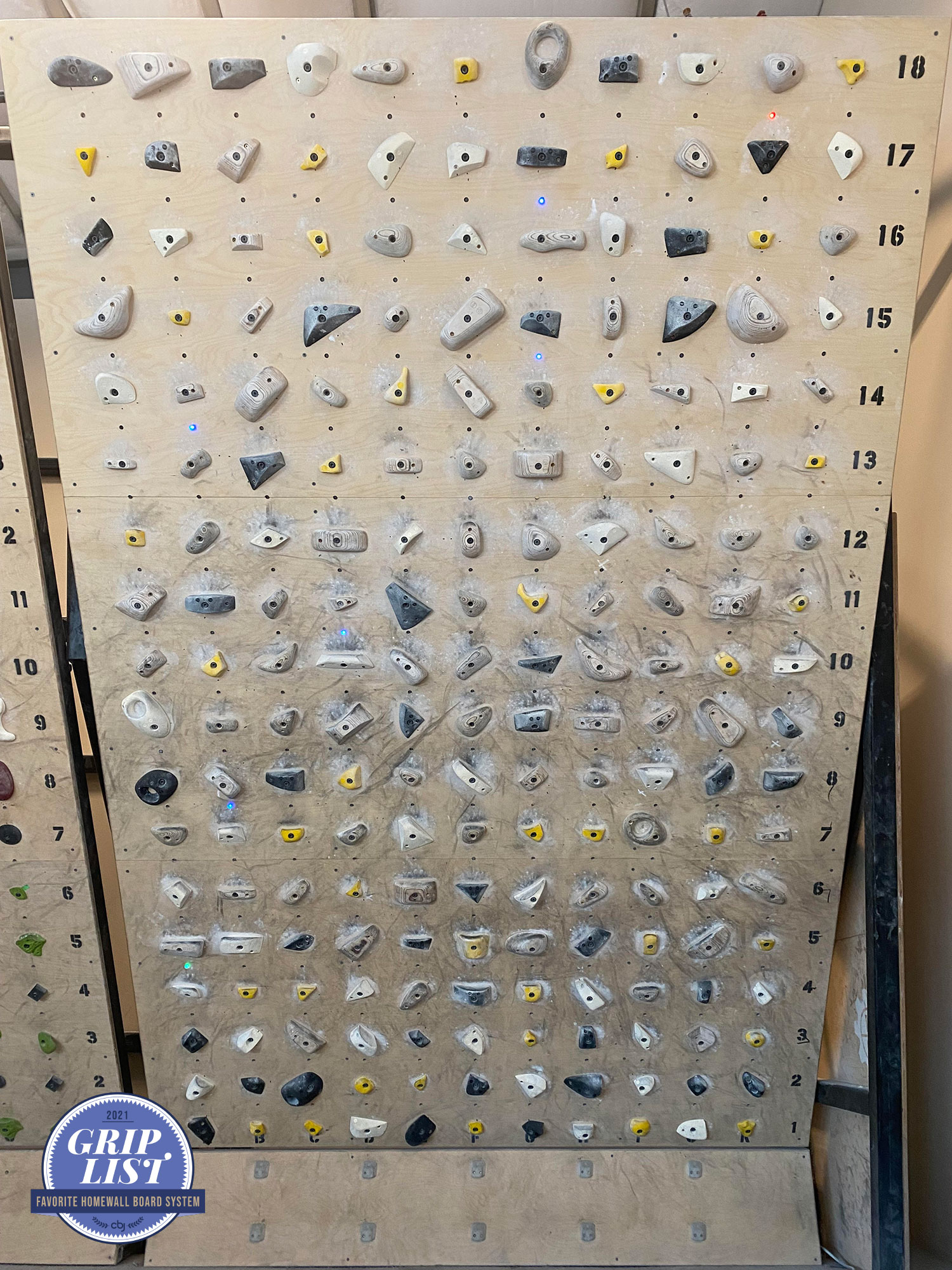
MoonBoard
Legendary climber Ben Moon pioneered the training board concept with the release of his original MoonBoard in 2006, which was based on designs he had used since the late 80s. Since then, his namesake board has been installed in thousands of climbing gyms and homewalls all over the planet, and the MoonBoard boasts a huge following and countless beta videos online.
Over the years, MoonBoard has released multiple unique hold layouts―2016, 2017, 2019, 2020 (Mini)―with each designed for a 25° or 40° wall and with LED lighting above the holds. The 2016 layout, in particular, is regarded as the first commercial LED board on the market. Most recently, the company released a new 2024 layout as well as four additional hold sets. The holds tend to be small, with the grades starting around V4, which can limit beginners and warm-ups. Moon said the initial idea was to cater to “the needs of a small but dedicated group of climbers who understood that a small, fixed hold training board was an exceptional strength training tool,” and that goal is seen in the designs.
MoonBoard was voted Favorite Homewall Board System in CBJ’s 2021 Grip List survey and runner-up in 2022 and 2023. They also proudly give 1% of all sales to environmental charities.
“The holds are perhaps the most realistic to outdoor climbing. I think the OG yellow holds do the best job simulating some of the nasty holds you have to grab outside.”
―Eddie Morillas, The Front Climbing Club (all four board systems installed)
“The small, deep in-cut holds favor a more powerful and tension-based climbing style.”
―Matt Waits, High Point Climbing & Fitness (three board systems installed)
“This board forces the climber to not hesitate and to be very deliberate with their movement. I also like the fact that this board is pretty simple and can fit in pretty small spaces.”
―Ken Klein, formerly at Whetstone Climbing (three board systems installed)
Learn more about the MoonBoard at www.moonboard.com
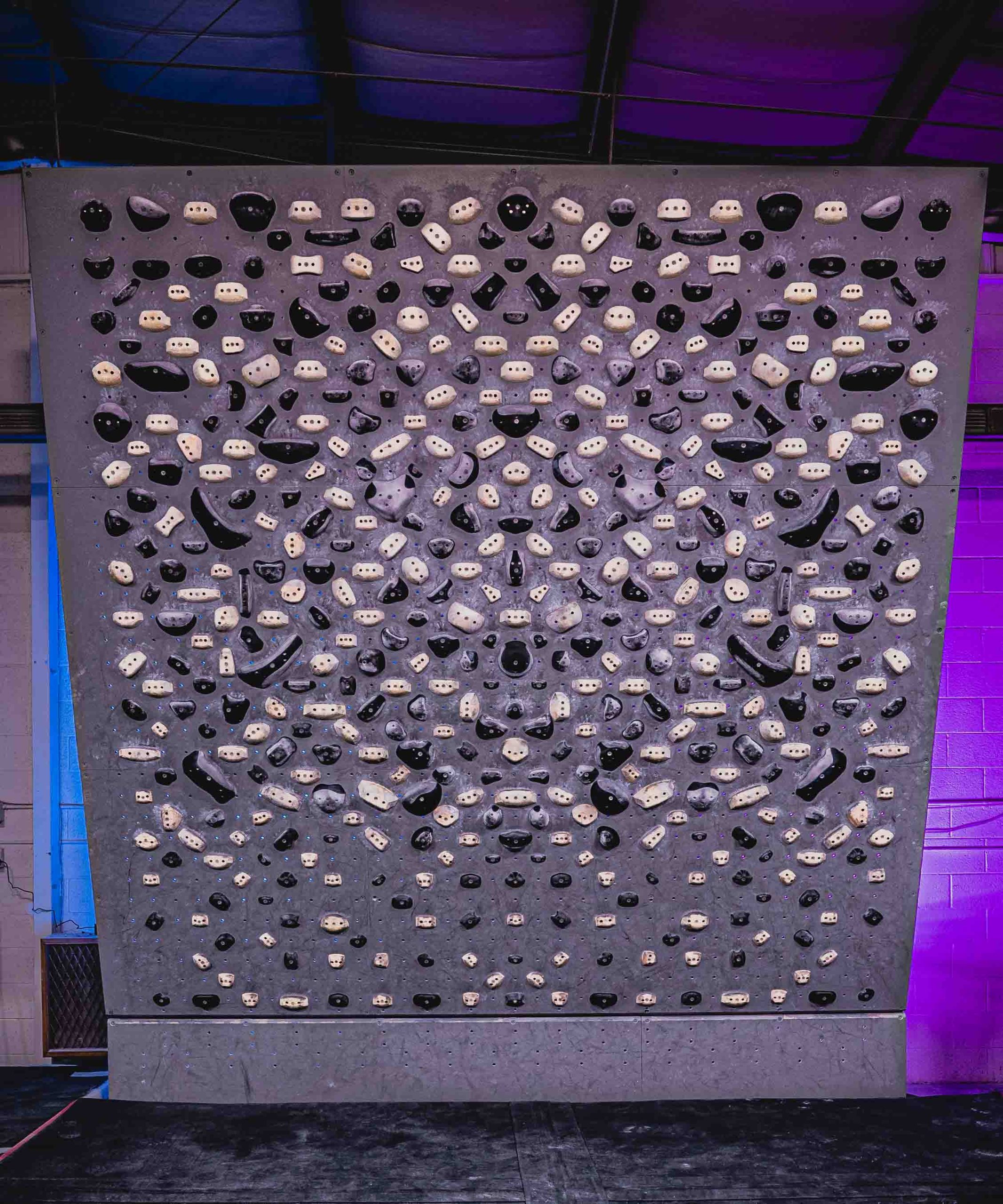
Tension Board
The folks at Tension introduced the second commercial LED training board on the market in 2017 with their Tension Board 1. It has a mirrored layout like system boards of the past, but with the modern conveniences of LED lights and a route database app, and the Tension Board 1 was also designed for use on adjustable-angle walls. The symmetry has attracted users who wish to target left and right-side movements equally. And by using 100% wooden holds, it’s an eco-friendly choice and regarded as a relatively skin-friendly board for long sessions.
In 2022, Tension released the Tension Board 2, a board system that supports adjustable wall angles from 0-65 degrees overhanging and includes wall sizes from 10’Hx8’W to 12’Hx12’W. The TB2 can be installed in a symmetrical (Mirror) and an asymmetrical (Spray) layout, giving users the ability to choose whichever layout they prefer, or switch up the layout later for a fresh feel and database of new climbs. For holds, the TB2 includes a combination of newly designed wooden holds and dual-tex, polyurethane holds that are illuminated from the center of each hold.
“The hold diversity of the TB2 allows you to target whatever you want out of your session. Crimps, pinches, powerful and static climbing—it’s all there.”
―Zach Galla, USA Climbing Athlete
“The wood holds are friendly on the skin and the symmetry helps identify weaknesses in your climbing. The climbing style leans more toward slower static movement.”
―Matt Waits, High Point Climbing and Fitness
“It’s probably the most appropriately named board. You need to keep it tight and have good technique for this one.”
―Eddie Morillas, The Front Climbing Club
Learn more about the Tension Board at www.tensionclimbing.com
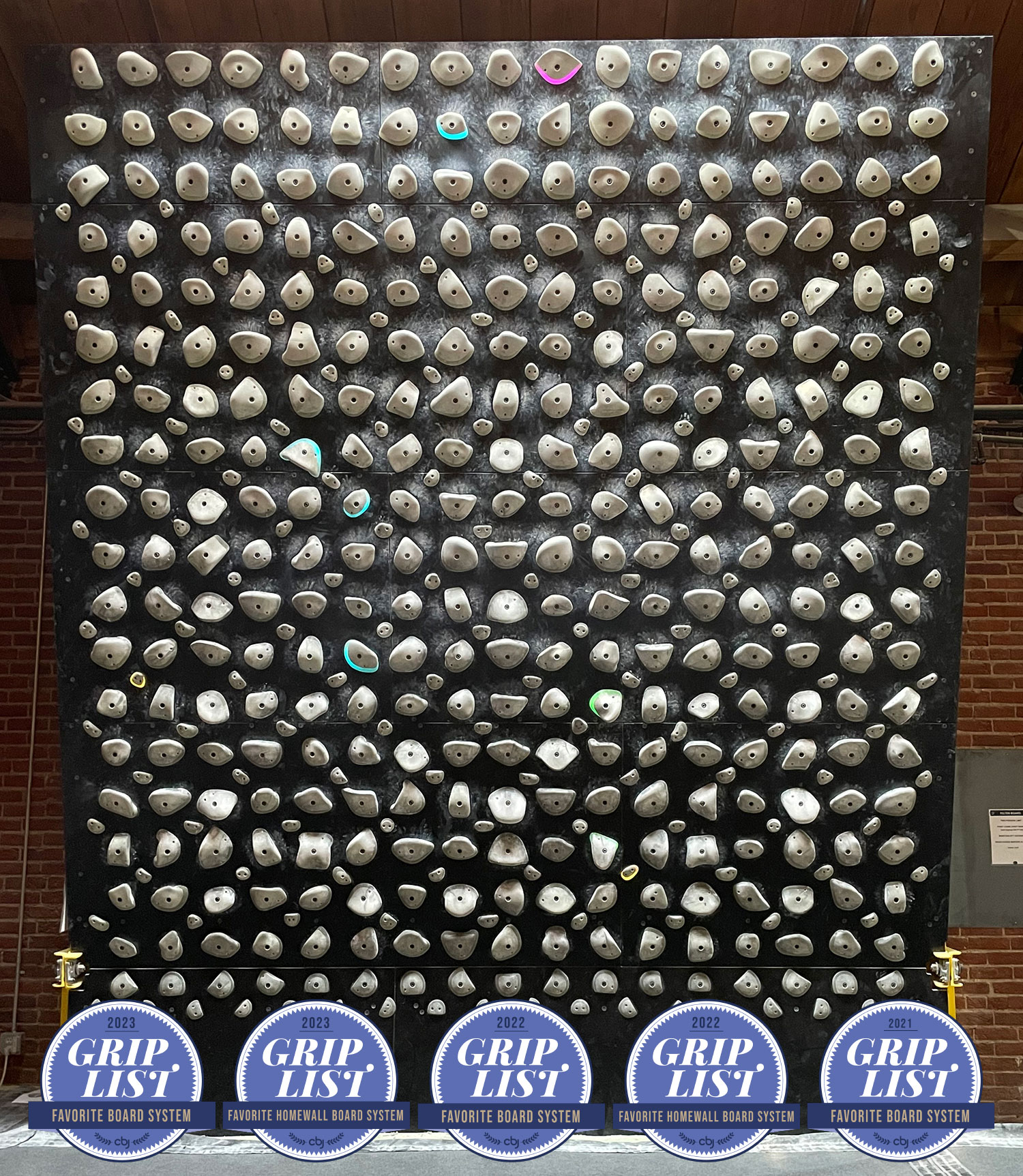
Kilter Board
Legendary sculptor Ian Powell brought his deep experience in hold shaping to the training board space with his and Jackie Hueftle’s introduction of the Kilter Board in 2018. Comfortable and varied shapes on an adjustable angle frame have made the Kilter Board a popular choice for entry-level and elite climbers alike. And the unique, full-perimeter LED lights which encircle the holds are designed to help make route sequences easier to follow, on and off the wall. Kilter also introduced the first paired manufactured frame: the freestanding, adjustable Lemur x Kilter frame, designed and engineered in partnership with Lemur Design out of Canada.
Though relatively new to the market at the time, the Kilter Board was voted Favorite Board System by routesetters in CBJ’s 2021 Grip List survey and was the runner-up Favorite Homewall System Board. The accolades have been pouring in since then, with the Kilter Board winning both votes in 2022 and 2023. There are over 1,000 Kilter Boards (and counting) installed around the globe, forming a worldwide network of climbers of all abilities and the largest problem database of any training board on the market.
“Functional for a wide range of climbing abilities.”
―Abbygael Cancian, Rock Mill Climbing
“The large, friendly hold shapes and fully lit hold design are less intimidating for new climbers and is the best way to introduce them to the world of climbing training.”
―Matt Waits, High Point Climbing and Fitness
“Accessible to beginners at lower angles.”
―Eddie Morillas, The Front Climbing Club
“I feel this is the easiest board to climb on.”
―Ken Klein, formerly at Whetstone Climbing
Learn more about the Kilter Board at www.setttercloset.com
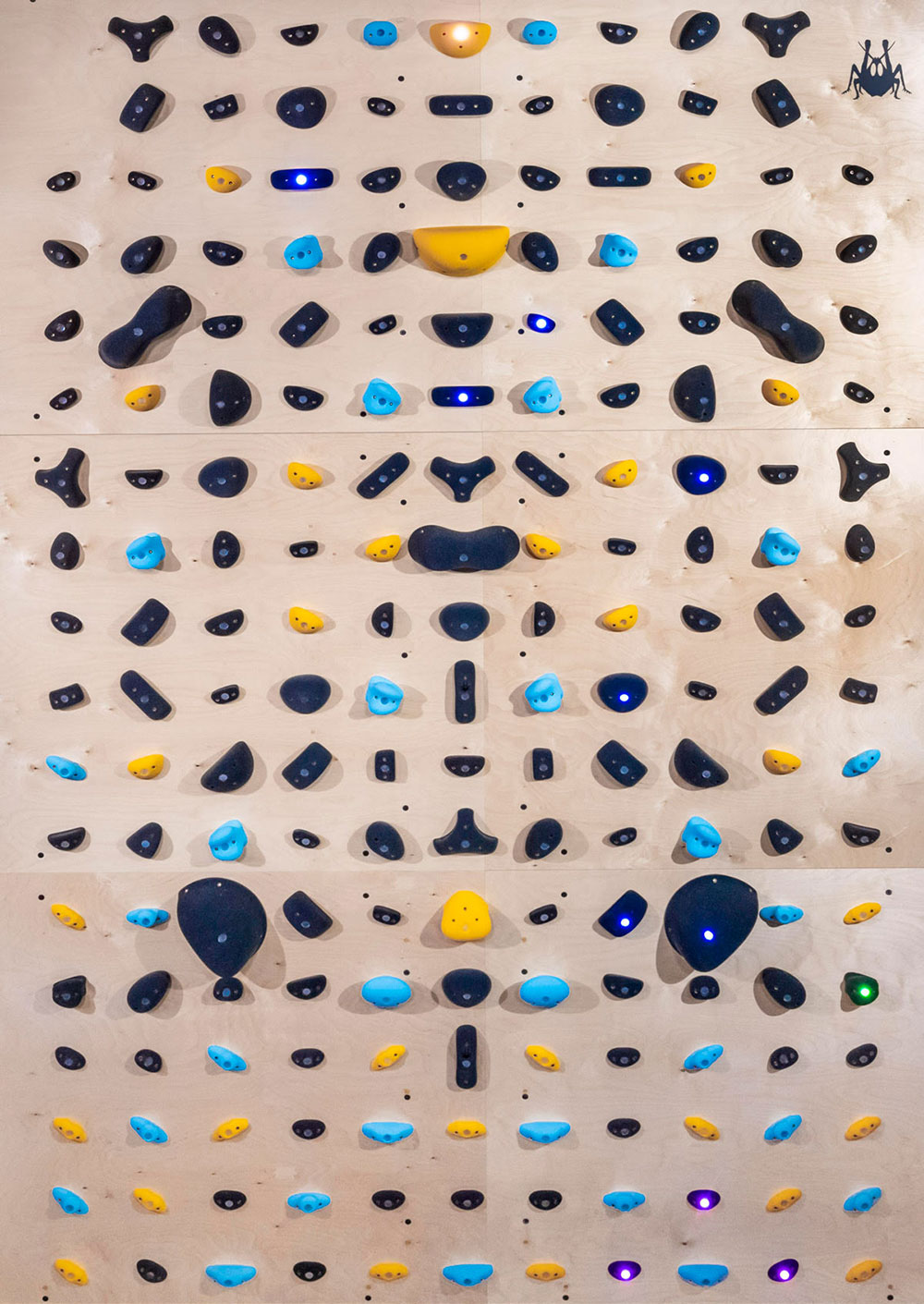
Grasshopper Board
Boone Speed launched his Grasshopper Board in 2020 during the pandemic, with a layout developed by Josh Larson. The company’s modern, adjustable frames pair with the hold systems for a sophisticated aesthetic. On the marketing front, Grasshopper is the Official Adjustable Training Wall of USA Climbing, and it’s not uncommon to see climbing Olympians training on this system on social media.
The mirrored Grasshopper Board was the first board to have some larger slopers and pinches included in the hold layout, and some say the bolt-hole LED lighting option improves on systems that have lights below the holds. In 2022, Grasshopper expanded its board to include optional 2ft panels on each side, yielding a 12×12 layout, adding several large slopers and pinches to the board. With some of the largest training board holds on the market, these large holds on the exterior of the wall allow climbers to avoid constantly hitting and dodging high-profile grips while working on smaller holds in the middle.
“Ergonomic grips…I like having larger and slopier holds.”
―Eddie Morillas, The Front Climbing Club
“The shapes are fun and interesting, with quite a lot of variety of sidepulls, slopers, pinches and underclings.”
―Kevin Corrigan, Climbing
Learn more about the Grasshopper Board at www.grasshopperclimbing.com
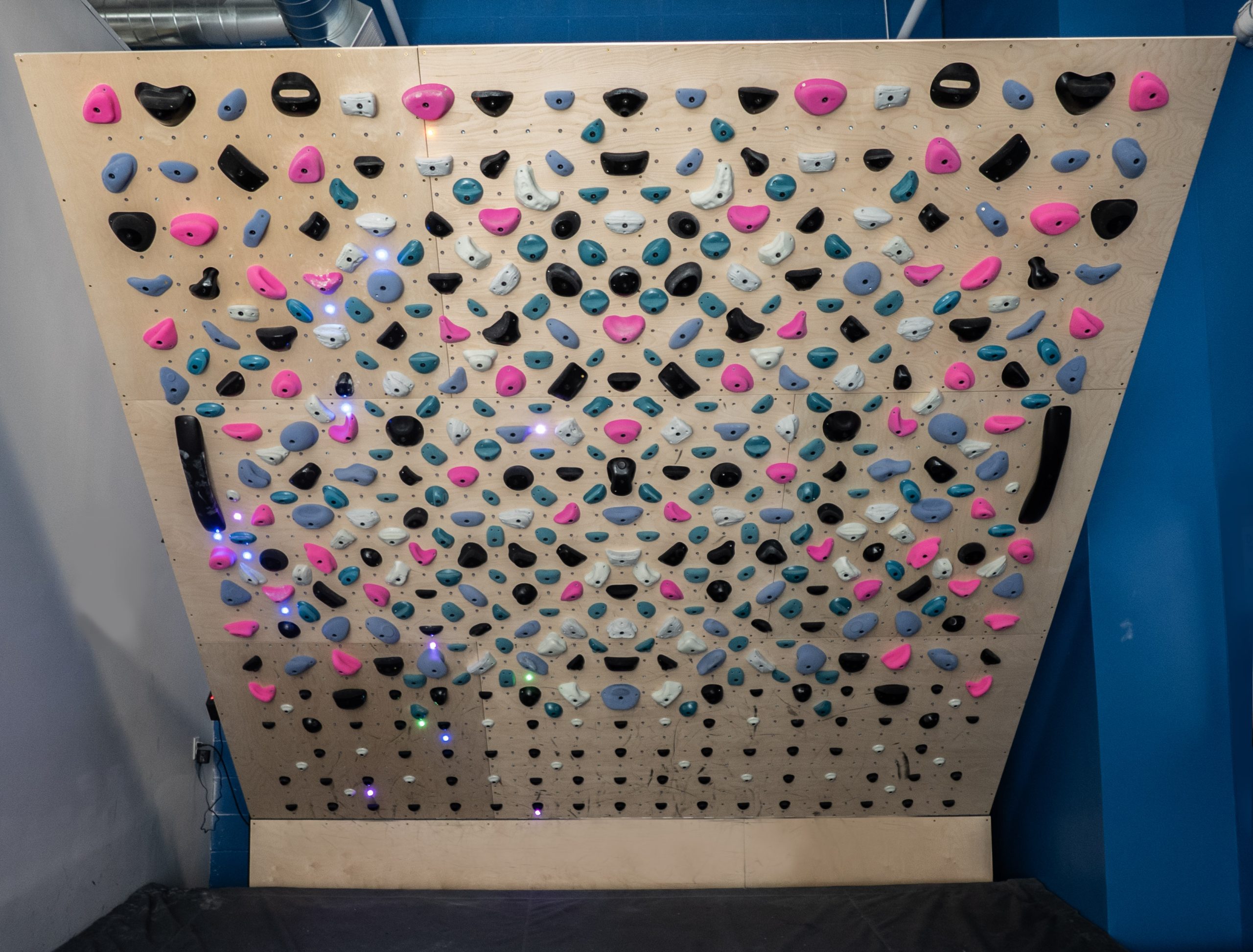
Decoy Board
In 2022, Decoy founder Dan Yagmin launched the Decoy Board, a symmetrical training board with a variety of holds from signature Decoy hold series, such as the Minimalist, Schist and Rollies. These series provide smooth, rock-like and dual-tex hold options across ten different sets, allowing climbers to expand their board over time. The Decoy Board App offers thousands of climbs at a variety of angles without a kickboard, to simulate outdoor climbing.
“It can be suitable for entry-level climbers as well as tame the strongest folks from your local crag.”
―Paul Jung, Director of Routesetting
“Being symmetrical has shown me some real weaknesses climbing on different sides. They have the most comfortable holds that are still bad and require tension and technique to climb in.”
―Samuel Gardner, VITAL Manhattan
“The decoy board is easy to interact with in a creative capacity, whether you are a professional setter or a community member trying out LED board climbing for the first time.”
―Ewan Bennett, Rock Spot Climbing
“It offers a distinct climbing experience that truly translates to outdoor climbing.”
―Lilian Kral, Boardworks Climbing
“Its versatility and appeal with our staff and customers has made it a staple for our training areas when looking to build new gyms.”
―Danny Howard, Rock Spot Gyms
Learn more about the Decoy Board at decoy-holds.com/pages/decoy-board
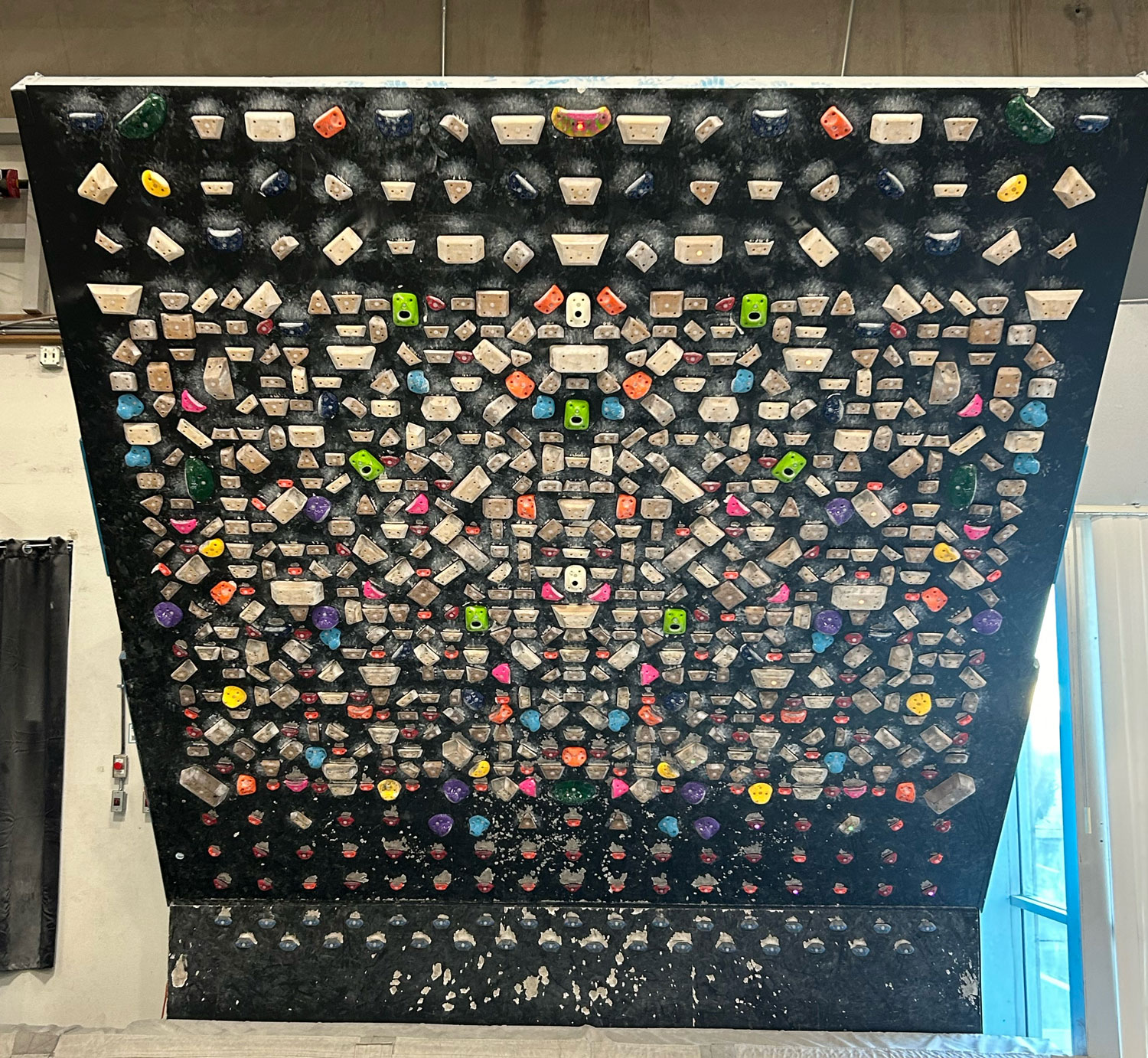
Woods Board
The Daniel Woods Light Up Training Board became available in the Winter of 2022, co-designed with Andy Raether, owner of Menagerie/Formik Climbing. With Woods and Raether’s combined climbing and industry experience, the design for the board came together quickly, resulting in a concept that caters to training enthusiasts looking for a hard sesh. The board consists of a densely-packed blend of wooden and dual-tex, plastic holds designed to be “ergonomic, useful and interesting.” The Woods Board app allows users to vie for top ranks on several leaderboards, propose grades, set boulders, and search through problems.
“Ultimately, the Woods Board aims to combine the core creative spirit of a spray wall with the symmetrical layout and global network of existing training boards.”
―Austin Beck-Doss, Gear Junkie
“The Woods board seems mega. More holds than any other board. It’s made for getting strong. It just seems mega.”
―Josh Aiken, Alpine Climbing Gym
“The reason you will want to climb on this board is because it will make you strong…The grips are hard, the moves are heavy, and progression will come.”
―Noah Walker, Gripped
Learn more about the Woods Board at menagerieclimb.com/pages/woods-board
Additional Training Board Hold Systems
The popularity of training board hold systems means inevitably there will be new entrants into the market as time goes on. Below are several other training board hold options; five are complete training board hold systems, and others are hold sets for DIY boards:
12Climb: 12Climb, based in Ukraine, has a 3×4-meter board system with light-up holds and a Bluetooth-connected app that’s intentionally built for climbers of lower grades and comes in two versions: the 12C Board, with grades ranging from 5b to 7c; and the 12C Board School, designed for beginning climbers and young children (4a to 6b route grades).
Nectar: Colorado-based Nectar Climbing’s Nectar Board system is a 10×12-foot wall (coming Spring 2024) that rotates and can be adjusted from 5° to 60° angles. The standardized hold set for the board consists of Urban Plastix holds paired with LED lights (coming Fall/Winter 2024).
Satellite: The Satellite Board system is distributed worldwide and comes in two sizes: 40° with 304 holds mainly for gyms, and a Mini (30° with 105 holds) for homewalls.
So iLL: So iLL is in the beta phase of its So iLL Connect Board system, with the beta version soon being delivered to locations around the world. They also make Systems Holds.
Wataaah: Wataaah’s Dojo board system is available in Europe as well as the U.S. and features 210 dual-tex, screw-on holds (105 unique shapes) with a mirrored layout for 20°-45° boards.
Atomik: While they don’t make a full board system, Atomik does produce a variety of plastic system holds for DIY board layouts.
Beastmaker: Beastmaker has four different wooden training board sets that can be used symmetrically or asymmetrically. The sets are designed to cater to various homewall setups and customer preferences, from wall angle to desired grade range.
Metolius: Metolius offers wooden system holds for DIY board layouts, featuring marks on the perimeter every 10° to assist with positioning.
Train to Climb: Train to Climb provides a coordination-style wall kit, which uses a symmetrical hold design for practicing a wide range of specific, dynamic movements.
More Resources About Training Board Systems
Here are more articles that provide additional details and perspectives on these invaluable training tools:
- Grip List Awards 2023: Kilter – Favorite Board System and Favorite Homewall Board System (Jonathan Littauer, CBJ, 10/29/2023)
- Grip List Awards 2022: Kilter – Favorite Board System and Favorite Homewall Board System (Jonathan Littauer, CBJ, 10/23/2022)
- Grip List Awards 2021: Kilter – Favorite Board System (Jonathan Littauer, CBJ, 9/12/2021)
- Grip List Awards 2021: Moon – Favorite Homewall Board System (Jonathan Littauer, CBJ, 9/12/2021)
- What’s Best For You: the Tension Board 2, the 2024 MoonBoard, or the Woods Board? (Matt Samet, Climbing, 3/26/2024)
- Get Lit: An Introduction to Interactive Climbing Boards (Lucie Hanes, Training 4 Climbing, 2/24/2023)
- First Looks – Daniel Woods and Menagerie Have New Standard Board (Noah Walker, Gripped, 2/26/2022)
- The Daniel Woods Training Board: Spray Wall-Inspired ‘Maximum Fun’ (Austin Beck-Doss, Gear Junkie, 2/18/2022)
- First Look: The Kilter Home Wall (Matt Samet, Climbing, 6/11/2021)
- The Decoy Board: World’s Newest Standard Board (Noah Walker, Gripped, 6/4/2021)
- Kilter, Moon, Grasshopper, and More: Interactive Climbing Training Boards Explained (Austin Beck-Doss, Gear Junkie, 5/14/2021)
- This Might Just Be the Ultimate Home Training Wall [Grasshopper] (Kevin Corrigan, Climbing, 4/27/2021)
- Which MoonBoard Set is the Best? (Noah Walker, Gripped, 3/12/2021)
- The Kilter Board is the Future of Board Climbing (Noah Walker, Gripped, 2/6/2021)
- Tension Board versus the MoonBoard (Noah Walker, Gripped, 11/16/2020)
- Is a MoonBoard for You? (Noah Walker, Gripped, 10/19/2020)
- MoonBoard Review (Rob Greenwood, UK Climbing, 4/4/2016)
Editor’s Note: Grasshopper, Kilter, Tension and So iLL are financial supporters of CBJ.
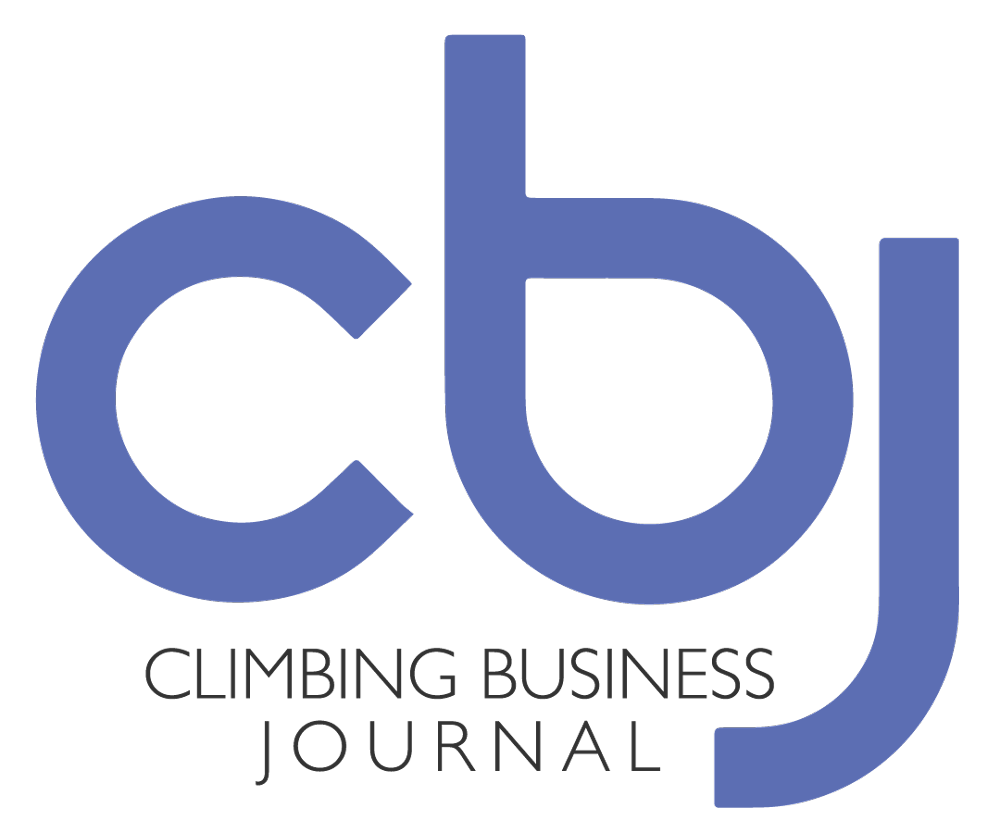
Climbing Business Journal is an independent news outlet dedicated to covering the indoor climbing industry. Here you will find the latest coverage of climbing industry news, gym developments, industry best practices, risk management, climbing competitions, youth coaching and routesetting. Have an article idea? CBJ loves to hear from readers like you!



